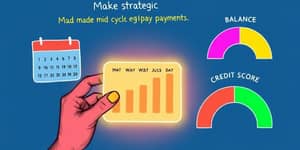Juggling multiple debts can feel like walking a tightrope, balancing minimum payments, interest rates, and due dates. For many, the weight of these obligations creates an unrelenting tension.
But there’s hope: a single manageable monthly payment can restore confidence and pave the way toward stability. DIY debt consolidation offers an accessible path for individuals ready to take charge of their finances and reclaim peace of mind.
What Is DIY Debt Consolidation?
DIY, or do-it-yourself debt consolidation, means combining several debts—credit cards, medical bills, personal loans—into one account that you oversee. This approach may involve taking a new loan, performing a balance transfer, or negotiating directly with creditors.
By uniting disparate obligations, you aim to simplify your financial life, reduce stress, and potentially lower your overall interest costs.
Primary Tools for Consolidation
- Personal loan with lower interest rate
- Balance transfer credit card with 0% intro APR
- Direct creditor negotiations for reduced rates
Core Steps in DIY Debt Consolidation
Before diving into consolidation, it’s vital to fully understand your starting point. Clarity is power when tackling debt.
- Inventory Your Debts: List balances, interest rates, and minimum payments.
- Assess Your Budget: Compare monthly income against expenses.
- Choose a Strategy: Snowball, avalanche, personal loan, or negotiation.
- Research Loan Options: Compare APRs, terms, and origination fees.
- Execute the Plan: Pay off existing accounts and manage one payment.
Completing each step ensures you make informed decisions rather than impulsive moves that might backfire.
Common Payoff Strategies Explored
Not all consolidation journeys look the same. Selecting the right payoff strategy depends on your goals—whether you seek quick wins or maximum interest savings.
• The snowball method tackles the smallest balances first, generating early victories that fuel motivation. A series of small successes can build momentum and reinforce positive habits.
• The avalanche method zeroes in on the highest-interest debt initially, minimizing the total interest you’ll pay over time. This disciplined approach prioritizes financial efficiency.
• A debt consolidation loan replaces multiple accounts with one fixed-rate payment. When your new APR is substantially lower than the weighted average of your existing debts, you stand to save money and streamline billing.
• Negotiation with creditors can lead to waived fees or reduced rates, but requires patience and persistence. Direct conversations may open doors to customized hardship plans.
When a Personal Loan Makes Sense
A personal loan for consolidation can be a game-changer if the following conditions align:
1. You Qualify for a Lower Rate: Your new APR must beat the current average of your debts. For many, card APRs exceed 20%, while those with good credit can secure loans at 7–15%.
2. You Have Multiple High-Interest Debts: Credit cards, medical bills, and payday loans all carry steep rates. Consolidating them can shift you onto a pathway of predictable payments.
3. You Seek Predictability: A fixed-term loan offers fixed-rate predictable payment and a clear payoff date, removing the anxiety of revolving debt.
4. Your Credit Score Supports It: Excellent (720+), good (670–719), or even fair scores (580–669) may qualify you—though rates improve as your score climbs.
5. The Loan Amount Meets Your Needs: Lenders often provide $1,000 to $50,000. Ensure it covers most or all of your outstanding balances.
Pros and Cons of a Consolidation Loan
Weigh these factors carefully. A loan can simplify your life, but it demands a commitment to disciplined repayment and spending restraint.
Alternatives to Personal Loan Consolidation
If a loan isn’t the right fit, consider other paths:
• A balance transfer card can offer 0% APR for a promo period—but you must clear the balance before rates resume.
• Direct negotiation may yield lower rates or fee waivers when you explain your hardship.
• The snowball and avalanche methods can be executed without borrowing, relying solely on disciplined extra payments.
• In severe cases, professional credit counseling or debt settlement might provide tailored assistance.
Key Pitfalls and Cautions
DIY consolidation isn’t risk-free. Be vigilant about:
• Qualification hurdles: Poor credit may lock you out of favorable terms.
• Fees and hidden costs: Read loan agreements to avoid unpleasant surprises.
• Discipline slip-ups: Consolidation frees available credit, tempting further purchases.
• Temporary credit dips: New inquiries and accounts reduce scores for a short time.
Making the Right Decision
Ask yourself:
- Will my total interest and fees be lower than before?
- Is my credit score strong enough for competitive rates?
- Can I maintain the new monthly payment throughout the term?
- Am I committed to a fresh financial start without accumulating additional debt?
Answering these questions honestly will guide you toward the path that best fits your situation.
Conclusion
DIY debt consolidation with a personal loan can transform a tangle of debts into a single, manageable commitment. By following a clear set of steps—inventorying debts, choosing the right strategy, and securing a favorable loan—you empower yourself to seize control of your financial destiny.
Remember, tools are only as effective as the hands that wield them. With consistent payments, responsible budgeting, and a commitment to change, you can move from stress and uncertainty to calm and confidence. Your journey toward financial freedom begins with a single decision: to consolidate, commit, and conquer.
References
- https://www.nationaldebtrelief.com/blog/debt-guide/debt-consolidation/diy-debt-consolidation/
- https://www.nerdwallet.com/article/loans/personal-loans/how-to-consolidate-credit-card-debt
- https://dfpi.ca.gov/news/insights/three-steps-to-managing-and-getting-out-of-debt/
- https://www.ombbank.com/blog/7-strategies-for-paying-off-debt
- https://www.navyfederal.org/makingcents/credit-debt/debt-repayment-strategies.html
- https://www.experian.com/blogs/ask-experian/pros-and-cons-of-debt-consolidation/
- https://www.experian.com/blogs/ask-experian/how-to-get-a-debt-consolidation-loan/
- https://www.cbsnews.com/news/credit-card-debt-relief-strategies-that-really-work/










